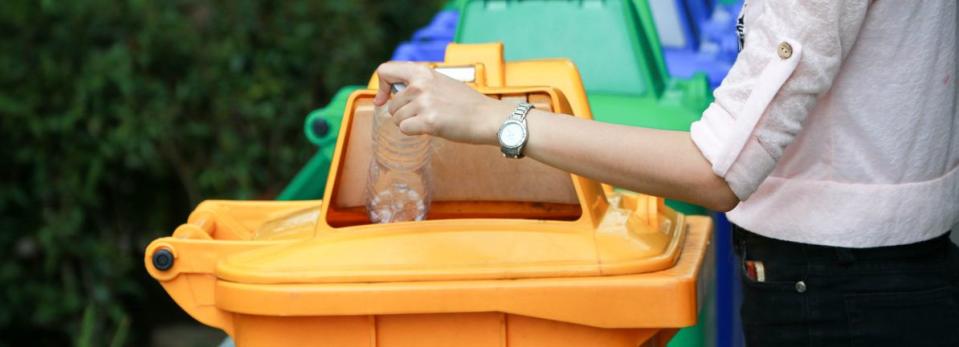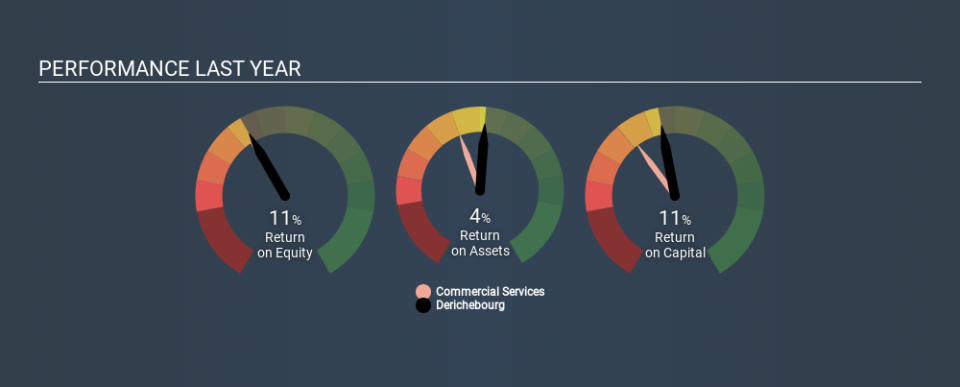A Close Look At Derichebourg SA’s (EPA:DBG) 11% ROCE

Today we'll look at Derichebourg SA (EPA:DBG) and reflect on its potential as an investment. In particular, we'll consider its Return On Capital Employed (ROCE), as that can give us insight into how profitably the company is able to employ capital in its business.
First, we'll go over how we calculate ROCE. Then we'll compare its ROCE to similar companies. Finally, we'll look at how its current liabilities affect its ROCE.
What is Return On Capital Employed (ROCE)?
ROCE measures the amount of pre-tax profits a company can generate from the capital employed in its business. All else being equal, a better business will have a higher ROCE. In brief, it is a useful tool, but it is not without drawbacks. Renowned investment researcher Michael Mauboussin has suggested that a high ROCE can indicate that 'one dollar invested in the company generates value of more than one dollar'.
How Do You Calculate Return On Capital Employed?
The formula for calculating the return on capital employed is:
Return on Capital Employed = Earnings Before Interest and Tax (EBIT) ÷ (Total Assets - Current Liabilities)
Or for Derichebourg:
0.11 = €101m ÷ (€1.6b - €613m) (Based on the trailing twelve months to September 2019.)
So, Derichebourg has an ROCE of 11%.
View our latest analysis for Derichebourg
Is Derichebourg's ROCE Good?
When making comparisons between similar businesses, investors may find ROCE useful. In our analysis, Derichebourg's ROCE is meaningfully higher than the 7.7% average in the Commercial Services industry. I think that's good to see, since it implies the company is better than other companies at making the most of its capital. Regardless of where Derichebourg sits next to its industry, its ROCE in absolute terms appears satisfactory, and this company could be worth a closer look.
We can see that, Derichebourg currently has an ROCE of 11% compared to its ROCE 3 years ago, which was 7.6%. This makes us wonder if the company is improving. The image below shows how Derichebourg's ROCE compares to its industry, and you can click it to see more detail on its past growth.
When considering this metric, keep in mind that it is backwards looking, and not necessarily predictive. ROCE can be deceptive for cyclical businesses, as returns can look incredible in boom times, and terribly low in downturns. This is because ROCE only looks at one year, instead of considering returns across a whole cycle. Future performance is what matters, and you can see analyst predictions in our free report on analyst forecasts for the company.
Do Derichebourg's Current Liabilities Skew Its ROCE?
Short term (or current) liabilities, are things like supplier invoices, overdrafts, or tax bills that need to be paid within 12 months. The ROCE equation subtracts current liabilities from capital employed, so a company with a lot of current liabilities appears to have less capital employed, and a higher ROCE than otherwise. To counteract this, we check if a company has high current liabilities, relative to its total assets.
Derichebourg has current liabilities of €613m and total assets of €1.6b. Therefore its current liabilities are equivalent to approximately 39% of its total assets. Derichebourg has a medium level of current liabilities, which would boost the ROCE.
Our Take On Derichebourg's ROCE
While its ROCE looks good, it's worth remembering that the current liabilities are making the business look better. Derichebourg shapes up well under this analysis, but it is far from the only business delivering excellent numbers . You might also want to check this free collection of companies delivering excellent earnings growth.
If you like to buy stocks alongside management, then you might just love this free list of companies. (Hint: insiders have been buying them).
If you spot an error that warrants correction, please contact the editor at editorial-team@simplywallst.com. This article by Simply Wall St is general in nature. It does not constitute a recommendation to buy or sell any stock, and does not take account of your objectives, or your financial situation. Simply Wall St has no position in the stocks mentioned.
We aim to bring you long-term focused research analysis driven by fundamental data. Note that our analysis may not factor in the latest price-sensitive company announcements or qualitative material. Thank you for reading.

 Yahoo Finance
Yahoo Finance 
